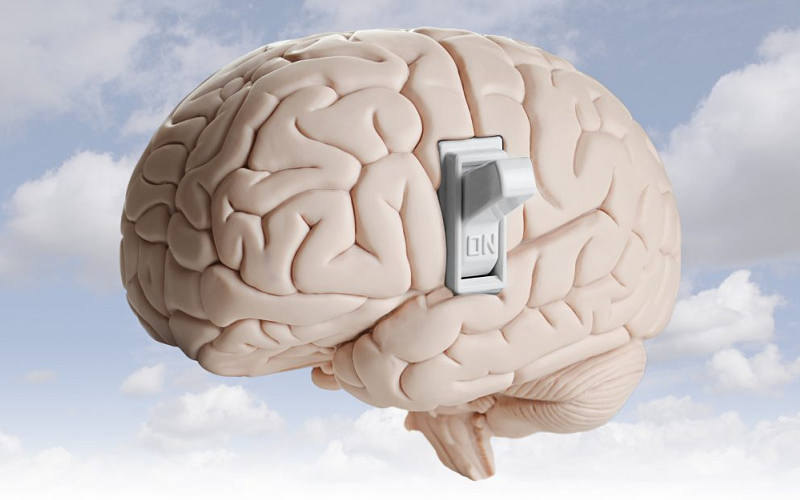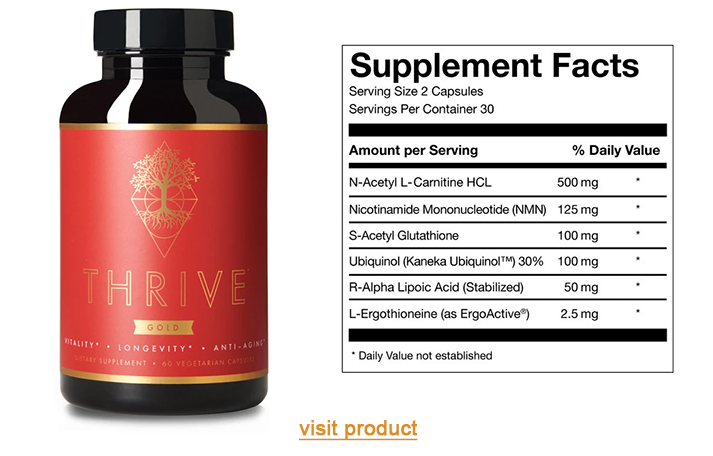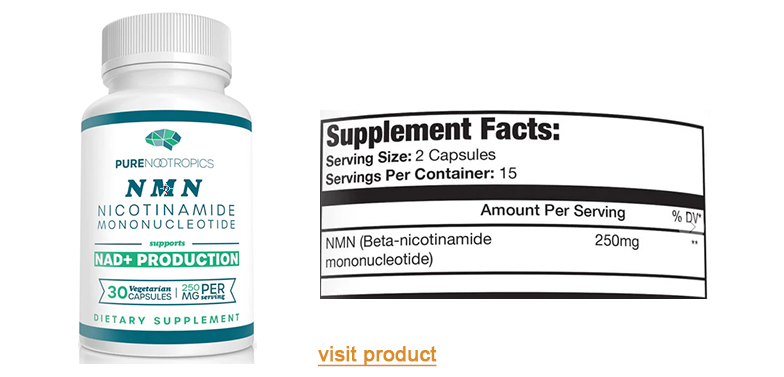Nicotinamide adenine dinucleotide, or NAD, is an antioxidant coenzyme present in every cell in the body. NAD creates adenosine triphosphate, or ATP, the energy source that powers cells. NAD’s role in ATP production enhances neurotransmitter production and increases mental energy, which improves cognitive function.
Nicotinamide mononucleotide, or NMN, is a precursor to NAD — NMN gets converted into NAD. For those looking to increase NAD levels through supplementation, it is actually more efficient to take an NMN supplement than it is to take a NAD supplement. This is due to NMN having superior bioavailability than NAD. Your body is better able to absorb NMN and then convert it to NAD than it is at absorbing and using NAD taken directly by supplementation.
Contents
NAD, NADH, NAD+: What’s In a Name?
Nicotinamide adenine dinucleotide, or NAD (pronounced en-aye-dee) is a coenzyme found in every cell of the body.
An enzyme is a protein which acts as a catalyst — it significantly accelerates a chemical reaction. An example of the use of an enzyme is in the digestive system, where enzymes help break down large complex molecules into smaller molecules — like glucose — so the body can use them as fuel.
Enzymes themselves are built from smaller molecules. One of the most important of these enzyme parts is the coenzyme. A coenzyme is a sort of helper molecule that aids an enzyme in catalyzing a chemical reaction. A coenzyme is never active on its own — it has to be a part of an enzyme to function.
Back to the coenzyme NAD. NAD is an extremely important coenzyme in that it is present in every cell, and plays an essential role in metabolism and the proper functioning of many different key molecules.
NAD exists in two forms: NAD+ and NADH. So the term NAD is used to collectively refer to the different forms of NAD — the molecules NAD+ and NADH.
NAD is always involved in carrying electrons from one reaction to another — this seemingly trivial act of shuffling electrons about is a big part of what makes enzymes work. When in the NAD+ form it accepts electrons from other molecules, and turns into NADH. In the NADH form it donates electrons to other molecules, and turns back into NAD+. So, the same NAD molecule is constantly cycling between NAD+ and NADH forms, without being consumed (used up and disappearing in chemical reactions). In a sense, there isn’t a molecule that is strictly NAD+ or NADH — the same NAD molecule can change form.
Why NAD Is Important
NAD is a coenzyme, a substance that enhances the action of enzymes. Enzymes are large molecules that catalyze (cause or accelerate a reaction by acting as a catalyst) biological processes — they create products necessary for survival. Without a coenzyme, enzymes are useless.
NAD is the top-ranked coenzyme — it is necessary for cellular development and energy production. It is a vital ingredient in the production of energy from food. It’s also the main carrier of electrons in the energy production process in the cells. NAD is also a very powerful antioxidant. It’s so important that it’s also known as coenzyme 1, with the 1 acknowledging that it is basically the number one ranked coenzyme.
NAD is a key part of cellular respiration, a process that involves mitochondria, ATP, and the electron transport chain.
Mitochondria are considered the powerhouses of the cell. Mitochondria are organelles — specialized structures within a cell that have a specific function. For mitochondria that specific function is making energy to power all of a cell’s functions. Mitochondria does this by turning adenosine diphosphate (ADP) into adenosine triphosphate (ATP). That process occurs in something called the electron transport chain, which, as its name implies, requires electrons to make things happen. It turns out that NAD is the source of the electrons mitochondria need to make this energy production happen.
Healthy cells play a huge role in healthy tissue and organs, and in minimizing age-related diseases. Mitochondria play a huge role in healthy cells. And NAD plays a huge role in healthy cells. So NAD has big role in anti-aging in general and, because NAD is most highly concentrated in the brain, it has a big role to play in healthy brain function. Within the brain, specifically, NAD’s role in ATP energy production increases mental energy, improves neurotransmitter production, thereby contributing to mental clarity and a general improvement in cognitive function. At this point you should be coming to the same conclusion many nutrition-minded people and many biological researchers have come to — maintaining sufficient levels of NAD is a big deal!
NAD Benefits
The coenzyme NAD is a powerful nootropic that enables the creation of energy in cells, and enables the transfer of that energy to cell functions that lessen aging and improve brain health. NAD is important to the body in a number of ways.
NAD Protects Brain Cells
When a body is deficient in NAD, it is the brain that’s the most impacted organ. One study found that NAD is key in regulating brain aging and tissue damage that accompanies some brain diseases.
NAD plays a significant role in replenishing the supply of neurotransmitters — molecules that are the body’s chemical messengers used by the nervous system to send messages between neurons (nerve cells). That’s important in boosting cognitive function and focus, as well as in helping to overcome depression, anxiety and chronic stress.
NAD is known to increase production of dopamine and norepinephrine — a pair of brain chemicals crucial to mental performance. Dopamine is associated with mood and motivation, helping a person attain the drive and focus needed to get things done. Norepinephrine enhances cognitive function and alertness, leading to clearer, quicker, thinking.
NAD’s powers as an antioxidant combat age-accelerating free radicals in the brain. This is a primary reason why NAD is often used as part of treatments for aging-related degenerative brain issues such as age-associated cognitive decline.
Increases Sirtuin Levels
Sirtuins are enzymes and a type of protein. They aren’t dietary proteins, but rather they’re molecules most active within cells. Sirtuins perform a number of functions, including playing a role in gene expression (whereby a cell responds to a changing environment by generating “products,” such as proteins), regulating cell health, fighting free radicals, and healthy aging.
A recent study demonstrated that increasing NAD levels raises sirtuin levels. The researchers’ conclusion was quite ambiguous, stating that NAD “supplementation looks be a very effective anti-aging intervention, providing promise to aging societies throughout the world.”
A body’s fight against free radicals and pathogens (virus, bacterium and other microorganism that cause disease) leads to inflammation. Sirtuins are known to be inflammation fighters, and NAD raises sirtuin levels.

How to Increase NAD Levels
When people are young they have plenty of NAD. As people age, however, they experience a steady, continuous decrease in NAD — and a corresponding decline in the proper functioning of tissues and organs. By middle age, a person’s NAD level will have typically dropped to only half the level during youth. By age 70, a person’s NAD level may have dropped by as much as 90%.
As our energy levels drop, our immune and inflammatory responses go haywire, and our ability to detoxify is compromised. In addition to decreasing NAD levels due to the internal biology of aging, NAD levels can be diminished by outside stresses, including sun exposure, overeating and drinking alcohol.
NAD Replenishment With NMN Supplements
Knowing that as people get older NAD levels invariably drop makes NAD supplementation an easy decision to make. And there are plenty of such supplements available on the market. There is one big issue with such supplements though — bioavailability.
Bioavailability is the proportion of a drug or other substance that ends up entering the circulation when introduced into the body — it’s the proportion that is able to have an active effect on the body. When a drug or other substance is administered intravenously, its bioavailability is 100% — right from the start it’s all in the bloodstream and ready to go to work. When a drug or other substance is administered orally, such as a supplement in pill form, the bioavailability is never 100% — due to the digestive process it’s always less than 100%, and sometimes much less than that.
With NAD supplements, bioavailability is in fact fairly low.
What happens after taking any supplement orally turns out to be a fairly complex — and oftentimes inefficient — process. The various compounds in a supplement need to survive the stomach acids that may destroy some of these compounds. Additionally, compounds need to pass through the small intestine into the bloodstream. NAD is considered a delicate molecule, and as a result its oral consumption results in much of the NAD components being destroyed.
Taking oral supplements of NAD isn’t a complete waste. During digestion and passing through the small intestine NAD is broken down into small molecules that serve as precursors of NAD. A precursor is a substance from which another, more active and more complex, substance is formed. In the case of NAD, one of these precursors is nicotinamide mononucleotide, or NMN. NMN has the ability to cross the intestinal barrier and reach cells intact, where — and this is important — it is converted into NAD.
A person can take NAD supplements, knowing that before reaching the bloodstream the NAD will be broken down into NAD precursors and eventually restored as NAD. But the digestive process means the breaking down of the NAD will result in relatively little remaining precursors. It is far better to start by taking oral supplements of just the precursor, knowing that most of the precursor will pass on to the cells and be converted to NAD. In short, the bioavailability of a precursor such as NMN is far greater than the bioavailability of complete NAD.
Studies show that the NMN precursor does indeed work to boost NAD, and ends up accomplishing the positive benefits of high NAD levels, such as reducing biological age (a person becomes younger than their chronological age).
NAD can be obtained from a person’s diet, so it would be nice if simply eating healthy foods satisfied NAD requirements — it would eliminate the need for NAD supplements of any kind, whether complete NAD or a NAD precursor such as NMN. Unfortunately, both NAD and its precursors are found in only trace amounts, and only then in some foods, including milk and fish such as salmons, sardines and tuna. It’s simply not possible to eat your way to NAD-boosting levels.
NAD supplements (labeled as either NAD+ or NADH) are widely available, while NMN supplements are available to a lesser degree. This is probably because of marketing — it’s simple for marketers to use the message: “NAD is good, so take NAD supplements.” Many people don’t know about, or understand, precursors. Additionally, NMN is more expensive than NAD. As far as bang for the buck, though, NMN wins — much of a NAD supplement is wasted, while far more of an NMN supplement reaches cells and ends up as NAD.
Thrive Gold from Awakened Alchemy is a good choice for a person looking to increase NAD levels, as it contains plenty of NMN (as well as other anti-aging, nootropic ingredients such as glutathione and acetyl-l-carnitine).
If you’re more interested in getting just the NMN, in a higher dose and without the extra ingredients included in Thrive Gold, then consider getting Pure Nootropics NMN Nicotinamide Mononucleotide. The only nootropic in the Pure Nootropics supplement is NMN.
NAD Replenishment With an IV Drip
Like anything a person ingests, there is a level of bioavailability associated with the substance. With any nutritional supplement, not all of the supplement becomes available for the body to use — the digestive process prevents the body from using 100% of the nutrients.
To get a higher bioavailability, some people turn to injections or IV therapy to by-pass the digestive system and get a nutrient directly into the bloodstream. You may have heard of vitamin B12 injections — B12 is by far the most common nutrient that’s available as an injection. A lesser known compound that can be taken in a manner such that it goes directly into the bloodstream is NAD.
While a bit of a buzzword today, NAD IV therapy has actually been around since the late 1960s. While sometimes referred to as NAD injections, the treatment is better known as NAD IV therapy as the NAD is administered with an IV drip. It’s preferable to introduce NAD slowly, so a one hour IV drip is much safer and healthier than injection by a shot.
As far as bioavailability, NAD IV therapy is undoubtedly superior to NAD (NMN) supplements — there are certainly benefits of NAD IV therapy. However, there are a couple of big downsides to increasing your NAD levels by intravenous therapy.
NAD IV therapy is inconvenient in that it needs to be given by a nurse, and the process takes a couple of hours (plus your travel time to the site that administers the treatment). A single treatment is effective for one to two weeks, so it’s a process that you have to continually perform. The biggest drawback, though, is the cost — NAD IV therapy cost up to $800 for a single treatment
Conclusion
NAD, or nicotinamide adenine dinucleotide, an antioxidant found in all cells. NAD creates ATP, or adenosine triphosphate, the primary energy that powers all the functions within a cell. NAD’s significant role in producing ATP leads to increased neurotransmitter production and increased mental energy, resulting in improved cognitive function.
NAD is produced from NMN, or nicotinamide mononucleotide — NMN is thus a precursor to NAD. NMN has much better bioavailability (the amount of a compound that is actually used by, and useful to, the body) than NAD, so for a person looking to increase NAD levels through supplementation, a daily dose of 125 mg of NMN is the preferred route to take.



